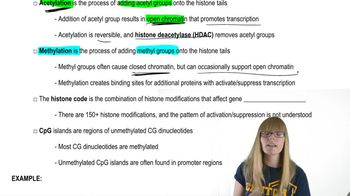How do microRNAs regulate epigenetic mechanisms during development?
Table of contents
- 1. Introduction to Genetics51m
- 2. Mendel's Laws of Inheritance3h 37m
- 3. Extensions to Mendelian Inheritance2h 41m
- 4. Genetic Mapping and Linkage2h 28m
- 5. Genetics of Bacteria and Viruses1h 21m
- 6. Chromosomal Variation1h 48m
- 7. DNA and Chromosome Structure56m
- 8. DNA Replication1h 10m
- 9. Mitosis and Meiosis1h 34m
- 10. Transcription1h 0m
- 11. Translation58m
- 12. Gene Regulation in Prokaryotes1h 19m
- 13. Gene Regulation in Eukaryotes44m
- 14. Genetic Control of Development44m
- 15. Genomes and Genomics1h 50m
- 16. Transposable Elements47m
- 17. Mutation, Repair, and Recombination1h 6m
- 18. Molecular Genetic Tools19m
- 19. Cancer Genetics29m
- 20. Quantitative Genetics1h 26m
- 21. Population Genetics50m
- 22. Evolutionary Genetics29m
13. Gene Regulation in Eukaryotes
Epigenetics, Chromatin Modifications, and Regulation
Problem 13
Textbook Question
Define epigenetics, and provide examples illustrating your definition.
 Verified step by step guidance
Verified step by step guidance1
Epigenetics is the study of heritable changes in gene expression that do not involve alterations to the underlying DNA sequence. These changes can affect how genes are turned on or off without modifying the genetic code itself.
One example of epigenetics is DNA methylation, where methyl groups are added to the DNA molecule, typically at cytosine bases in CpG islands. This modification can suppress gene expression by preventing transcription factors from binding to the DNA.
Another example is histone modification, where chemical groups such as acetyl, methyl, or phosphate groups are added to histone proteins. These modifications can alter the chromatin structure, making it either more open (euchromatin) or more condensed (heterochromatin), thereby influencing gene expression.
A third example is RNA-based mechanisms, such as non-coding RNAs (e.g., microRNAs) that can regulate gene expression post-transcriptionally by degrading mRNA or inhibiting its translation.
Epigenetic changes can be influenced by environmental factors such as diet, stress, and exposure to toxins, and they can sometimes be passed on to offspring, demonstrating their heritable nature.
 Verified video answer for a similar problem:
Verified video answer for a similar problem:This video solution was recommended by our tutors as helpful for the problem above
Video duration:
2mPlay a video:
Was this helpful?
Key Concepts
Here are the essential concepts you must grasp in order to answer the question correctly.
Epigenetics
Epigenetics is the study of heritable changes in gene expression that do not involve alterations to the underlying DNA sequence. These changes can be influenced by various factors, including environmental conditions, lifestyle, and developmental stages. Epigenetic modifications, such as DNA methylation and histone modification, can activate or silence genes, thereby affecting how cells read the genetic code.
Recommended video:
Guided course

Chromatin
DNA Methylation
DNA methylation is a key epigenetic mechanism that involves the addition of a methyl group to the DNA molecule, typically at cytosine bases. This modification can inhibit gene expression by preventing the binding of transcription factors or recruiting proteins that compact the DNA, making it less accessible for transcription. For example, increased methylation of tumor suppressor genes can lead to their silencing, contributing to cancer development.
Recommended video:
Guided course

DNA Proofreading
Histone Modification
Histone modification refers to the chemical alterations of histone proteins around which DNA is wrapped, influencing gene accessibility and expression. Common modifications include acetylation, methylation, and phosphorylation, which can either promote or inhibit transcription. For instance, acetylation of histones generally leads to a more open chromatin structure, facilitating gene expression, while certain methylation patterns can lead to gene repression.
Recommended video:
Guided course

Histone Protein Modifications
Related Videos
Related Practice
Textbook Question
658
views


